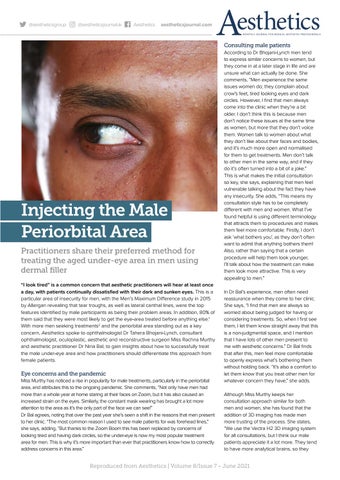@aestheticsgroup
@aestheticsjournaluk
Aesthetics
aestheticsjournal.com
Consulting male patients
Injecting the Male Periorbital Area Practitioners share their preferred method for treating the aged under-eye area in men using dermal filler “I look tired” is a common concern that aesthetic practitioners will hear at least once a day, with patients continually dissatisfied with their dark and sunken eyes. This is a particular area of insecurity for men, with the Men’s Maximum Difference study in 2015 by Allergan revealing that tear troughs, as well as lateral canthal lines, were the top features identified by male participants as being their problem areas. In addition, 80% of them said that they were most likely to get the eye-area treated before anything else.1 With more men seeking treatments2 and the periorbital area standing out as a key concern, Aesthetics spoke to ophthalmologist Dr Tahera Bhojani-Lynch, consultant ophthalmologist, oculoplastic, aesthetic and reconstructive surgeon Miss Rachna Murthy and aesthetic practitioner Dr Nina Bal, to gain insights about how to successfully treat the male under-eye area and how practitioners should differentiate this approach from female patients.
Eye concerns and the pandemic Miss Murthy has noticed a rise in popularity for male treatments, particularly in the periorbital area, and attributes this to the ongoing pandemic. She comments, “Not only have men had more than a whole year at home staring at their faces on Zoom, but it has also caused an increased strain on the eyes. Similarly, the constant mask wearing has brought a lot more attention to the area as it’s the only part of the face we can see!” Dr Bal agrees, noting that over the past year she’s seen a shift in the reasons that men present to her clinic. “The most common reason I used to see male patients for was forehead lines,” she says, adding, “But thanks to the Zoom Boom this has been replaced by concerns of looking tired and having dark circles, so the under-eye is now my most popular treatment area for men. This is why it’s more important than ever that practitioners know how to correctly address concerns in this area.”
According to Dr Bhojani-Lynch men tend to express similar concerns to women, but they come in at a later stage in life and are unsure what can actually be done. She comments, “Men experience the same issues women do; they complain about crow’s feet, tired looking eyes and dark circles. However, I find that men always come into the clinic when they’re a bit older. I don’t think this is because men don’t notice these issues at the same time as women, but more that they don’t voice them. Women talk to women about what they don’t like about their faces and bodies, and it’s much more open and normalised for them to get treatments. Men don’t talk to other men in the same way, and if they do it’s often turned into a bit of a joke.” This is what makes the initial consultation so key, she says, explaining that men feel vulnerable talking about the fact they have any insecurity. She adds, “This means my consultation style has to be completely different with men and women. What I’ve found helpful is using different terminology that attracts them to procedures and makes them feel more comfortable. Firstly, I don’t ask ‘what bothers you’, as they don’t often want to admit that anything bothers them! Also, rather than saying that a certain procedure will help them look younger, I’ll talk about how the treatment can make them look more attractive. This is very appealing to men.” In Dr Bal’s experience, men often need reassurance when they come to her clinic. She says, “I find that men are always so worried about being judged for having or considering treatments. So, when I first see them, I let them know straight away that this is a non-judgmental space, and I mention that I have lots of other men present to me with aesthetic concerns.” Dr Bal finds that after this, men feel more comfortable to openly express what’s bothering them without holding back. “It’s also a comfort to let them know that you treat other men for whatever concern they have,” she adds. Although Miss Murthy keeps her consultation approach similar for both men and women, she has found that the addition of 3D imaging has made men more trusting of the process. She states, “We use the Vectra H2 3D imaging system for all consultations, but I think our male patients appreciate it a lot more. They tend to have more analytical brains, so they
Reproduced from Aesthetics | Volume 8/Issue 7 - June 2021
















